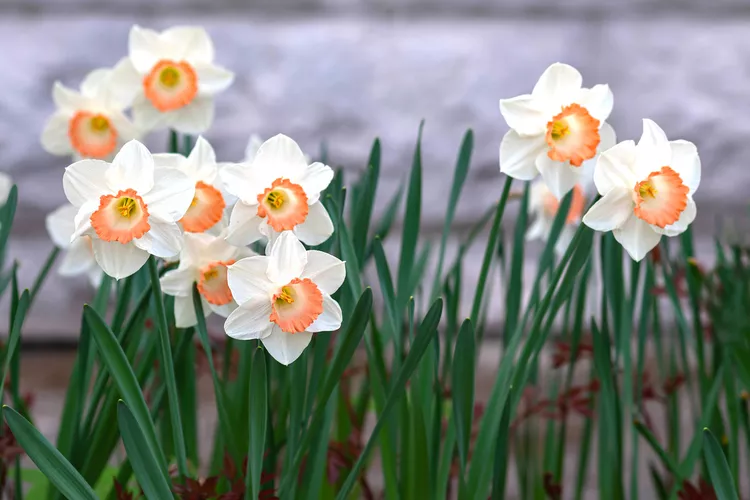Ask most people to name the color of a daffodil, and they’ll answer, “Yellow, of course.” Yellow trumpet daffodils are always the first to announce the beginning of daffodil (Narcissus) season, but keep your eyes out for the less common pink daffodils that join the show a few weeks later. To get the most out of these types of daffodils, you’ll need to know the best varieties, where to plant them in your landscape, and how to keep their radiant pink color glowing as long as possible.
Pink daffodils have pink center cups (coronas), and the outer petals are usually white or ivory, but you’ll see some pale yellow. The shades of pink are always on the warm end of the spectrum, like salmon, peach, or apricot, rather than hot pink. The flowers are intriguing to watch because the colors develop over several days, with the cup changing from yellow to pink or the rim turning a bright pink or yellow. The variations can depend on the temperature, and the blooms one year can vary from the next, making your pink daffodils a daily delight.
The Best Pink Daffodils to Grow
Guarantee your success by beginning with the must-haves: award-winning pink daffodil varieties that will reward you with luminous flowers. The ultimate accolade in the daffodil world is the Wister Award, given each year by the American Daffodil Society to a daffodil with proven performance in home gardens. Choose from the following six pink-hued Wister Award winners, and you'll be off to a great start.
1. 'Fragrant Rose’ Daffodil
If you had to select just one pink daffodil to plant, ‘Fragrant Rose’ is a show-stopper. It has a strong rose or raspberry scent and a deep reddish-pink cup set off by beautifully formed white petals. It blooms in mid to late season in Zones 4-8 and grows 14-18 inches tall.
2. 'Pink Charm’ Daffodil
Another favorite is the sweet ‘Pink Charm’ with ivory petals surrounding a cup that boasts a ruffled rim of coral pink. Plant this pink daffodil in Zones 3-8 and watch it grow to 14-16 inches tall.
3. 'Accent' Daffodil
The American Daffodil Society calls ‘Accent’ a classic. Introduced in 1960, it still impresses in the garden with its salmon-pink cup, white petals, and vigorous growth in Zones 3-8. It reaches a height of 14-16 inches.
4. 'Chromacolor’ Daffodil
Sometimes kids are bigger than their parents, and a child of ‘Accent’ is ‘Chromacolor’–a bit taller, with a wider and more deeply colored, peachy-pink cup. The venerable Royal Horticultural Society gave it an Award of Garden Merit in 2001. If you want an attention getter in Zones 3-8, try this one.
5. 'Salome’ Daffodil
Your grandparents may have grown ‘Salome’, and this daffodil of the 1950s still deserves a place of honor in your garden. The rapidly changing flower opens with ivory petals that turn white while the cup evolves from yellow to apricot-pink with a yellow rim. It’s a late bloomer for gardens in Zones 3-7 that gets 18-20 inches tall.
6. 'Blushing Lady’ Daffodil
All of these are large cup daffodils, but ‘Blushing Lady’ is an award-winning jonquil daffodil (another category of Narcissus). This fragrant pink daffodil thrives from chilly Zone 4 into Zone 9, grows 12 to 14 inches tall, and blooms late in the season. It has an unusual color combination with soft yellow petals and a cup that turns pink as it matures. You’ll have more blooms to enjoy because it typically has three flowers on each stem. This special flower won the Wister Award in 2022.
Pink Daffodils for Warm Climates
The ‘Blushing Lady’ jonquil pink daffodil is your best bet for Zone 9, but leaf through the bulb catalogs for more jonquil or tazetta daffodils (like ‘Kapiti Peach’), which are well-suited to the extra warmth in the South. Otherwise, if you want to grow daffodil bulbs that require a cold winter to flower, don’t forget that some bulb suppliers will pre-chill daffodil bulbs for you.
How to Keep Pink Daffodils from Fading
If pink daffodils get full sun like others, they can lose their pink coloration. According to daffodil expert Brent Heath of Brent & Becky's Bulbs, who bred 'Blushing Lady,' "the source of the pink daffodil color is from the thin red rim on the cup of the ancient poet's daffodil." For generations, breeders used that red rim to create flowers with red, orange, or pink cups. Carotene (yes, like carrots) "causes the color, but at the moderate levels in pink daffodils, it interacts with sunlight and fades," says Heath. The Wister Award winners are less likely to fade, and some varieties are described as "sunproof," meaning they're the most robust pink daffodils in sunny conditions.
Besides choosing these sunproof varieties, Heath suggests that you maximize the color of your pink daffodils in two ways. First, plant them where they'll get morning and afternoon shade or filtered sun all day. Second, fertilize them each year. Heath recommends making a fall application of "azomite powder ($15, Walmart), according to package directions, to replenish the trace minerals and micronutrients in the soil." Then, add a 1-inch layer of compost and a thin layer of mulch.
Tips for Planting Pink Daffodils
Once you’ve figured out where to plant your pink daffodils, plant them like any other daffodil bulbs. Adding a few other spring-blooming bulbs to your daffodils is an easy way to enhance their already- stunning effect. Create a “color echo” with the apricot hyacinth ‘Gipsy Queen’ and plant blue-violet grape hyacinths at their bases for a striking contrast. Heath suggests planting pink daffodils with Spanish bluebells like heirloom ‘Excelsior’. And make sure to plant enough pink daffodils to have plenty of flowers to pick for your vases.




















